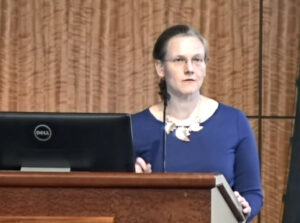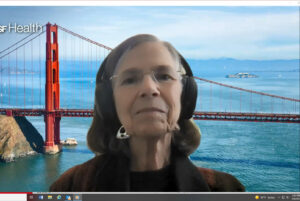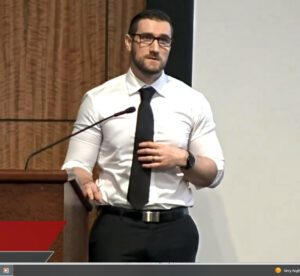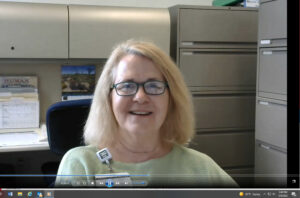View Larger Image
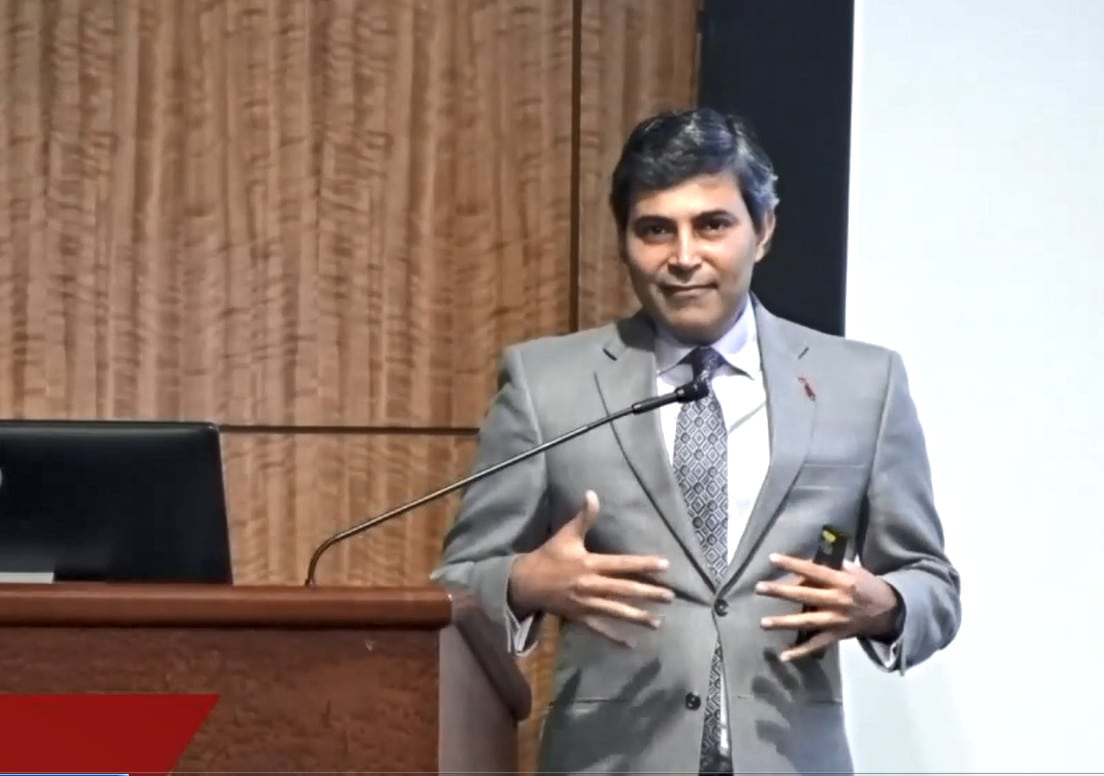
Rohit Dhall, M.D., discusses the new Virtual Parkinson's Education Library.
UAMS Unveils Virtual Parkinson’s Education Library at Symposium
| Parkinson’s disease patients shouldn’t underestimate the power of staying physically active as well as socially and mentally engaged, according to movement disorders specialists that came together April 24 for a virtual symposium designed for patients, their caregivers and clinicians.
The Seventh Annual Parkinson’s Symposium put on by the Movement Disorders Clinic at the University of Arkansas for Medical Sciences (UAMS) to close out National Parkinson’s Month featured a multidisciplinary group of UAMS experts who work with Parkinson’s patients and a Parkinson’s expert from San Francisco.
Viewers learned about a new Virtual Parkinson’s Education library put together by the UAMS movement disorders team, links between Parkinson’s disease and mood disorders, and an ongoing national study called TOPAZ (Trial of Parkinson’s and Zoledronic Acid).
Rohit Dhall, M.D., a UAMS professor of neurology and director of neurodegenerative disorders, kicked off the Sunday afternoon symposium by unveiling the library that was compiled over the last year with help from a National Institutes of Health grant.
It includes 3½ hours’ worth of five- to seven-minute videos, each focused on particular topics related to Parkinson’s, and each including a link to other resources on the topic. Dhall urged patients and caregivers to use the library, saying it’s impossible for doctors to convey that amount of information during periodic clinic visits.
Some of the videos were made by UAMS specialists and all were reviewed by the UAMS team. Dhall said the library is divided into seven chapters that provide an overview of Parkinson’s disease, focus on symptoms, explain treatment options and offer suggestions for living well with the disease, as well as preparing for visits with providers.
It can be accessed through https://redcap.link/PDSurvey or by sending a request to Dhall at RDhall@uams.edu or Suzanne Dhall, the clinic’s health educator, at SJDhall@uams.edu. Participants are encouraged to answer some preliminary and post-segment questions to help the UAMS team define areas of concern and ensure the information provided is helpful.
Dhall emphasized the importance of obtaining information on Parkinson’s from movement disorders specialists rather than general practitioners, noting that most family medicine physicians receive about 16 hours of training in movement disorders during four years of medical school, while neurology residents receive about 120 hours of training on Parkinson’s and related disorders.
Also, he said, “here at the university, you’re not just coming to see one provider. You have an entire team her to help you — people with expertise that is much harder to access” otherwise.
“Not every patient needs to see a movement disorders specialist every single time, but it is invaluable to have at least one visit with a movement disorders doctor and a multidisciplinary team,” Dhall said.
Caroline Tanner, M.D., Ph.D., director of the Parkinson’s Disease Research, Education and Clinical Center at the San Francisco Veterans Affairs Medical Center and a professor of neurology at the Weill Institute for Neurosciences at the University of California-San Francisco, was the featured speaker. She said that 3,500 men and women — all of whom must be over 60 and have Parkinson’s disease or another neurodegenerative disorder — are still needed to participate in the study, which is focused on preventing fractures.
Half will get the drug, which strengthens the bone, and the other half will receive a placebo. After obtaining a single infusion, clinic visits aren’t required, but participants will be followed for two years. More information on the study is available at TOPAZstudy.org.
Tanner, who is known nationally for her research into Parkinson’s, said people who have the disease have a 2½ times greater risk than other people of the same age for developing osteoporosis, osteopenia and fractures, yet only about 3% of Parkinson’s patients are treated for osteoporosis.
She said people with and without Parkinson’s are needed for a variety of research studies related to Parkinson’s disease and emphasized that volunteers are essential for making advances in Parkinson’s, which occurs only in humans. For more information on various studies, she suggested visiting foxtrialfinder.org, clinicaltrials.gov or talking to a neurologist.
Lee Isaac, Psy.D., a UAMS neuropsychology postdoctoral fellow who will be joining the UAMS faculty in July, said that about half of people with Parkinson’s will experience clinical depression or anxiety, which “can happen at any stage of the disease,” even in some cases before the physical symptoms of Parkinson’s appear.
“The same system that causes changes in motor functioning can cause changes in emotional functioning,” Isaac said.
He said apathy, or a general dulling of emotions, is “very common” in brain-based disorders and is commonly misperceived as depression. He said treatment is available through medications, psychotherapeutic interventions and behavioral management, but it’s also important for Parkinson’s patients to stay physically, socially and cognitively active to prevent, postpone and decrease symptoms.
“Doing something that really brings you a sense of purpose and mastery can really help you manage some of these symptoms,” Isaac said. “Remaining socially active can have a profound effect on our mood symptoms.”
Virtual attendees also heard from Kellie Coleman, fitness center coordinator at the UAMS Donald W. Reynolds Institute on Aging, which offers exercise classes specifically for Parkinson’s patients.
“Exercise will really help you get in a better mood,” she said. “Exercise really is medicine. Starting an exercise routine and consistently exercising have very positive effects on quality of life and mobility for people with Parkinson’s disease.”
Coleman urged Parkinson’s patients to perform aerobic, strength and skill-based exercises, and to start as soon as possible after a Parkinson’s diagnosis, although, “even when you’re in your 90s, it’s not too late.”
She said 30 minutes of cardiovascular exercise daily and strength training twice a week is recommended, but, “even two minutes at a time helps.”
